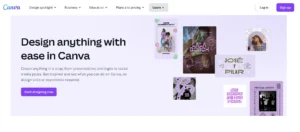Figma vs Canva: 7 Key Differences to Help You Choose the Right Tool

For years, the lines in the design world were clearly drawn. If you were a professional UI/UX designer building an app or a complex website, you used Figma. If you were a marketer or small business owner needing a quick social media graphic, you used Canva. In 2025, those lines have blurred into non-existence.
Canva has become more powerful, and Figma has become more collaborative, creating a genuine dilemma for teams and individuals. The Figma vs Canva debate is no longer about pro vs. amateur; it’s about choosing the right tool for a specific job. Are you building a design system from scratch, or do you just need a beautiful presentation in 20 minutes? Your answer will determine your winner in the Figma vs Canva showdown.
This guide will break down the 7 key differences between these two design giants to help you make an informed decision and choose the right tool for your specific needs.
First, a Quick Introduction

- Figma: A powerful, browser-based interface design tool focused on professional UI/UX design, prototyping, and building robust design systems for teams.
- Canva: An incredibly user-friendly, template-driven design platform aimed at making design accessible to everyone for a vast range of assets, from social media posts to videos and websites.
The 7 Key Differences: Figma vs Canva

Let’s dive into the core of the Figma vs Canva comparison.
1. Primary Use Case & Design Philosophy
The biggest difference lies in their core philosophy.
- Figma: Was built from the ground up for interface design. It gives you a blank, infinitely flexible canvas and a powerful vector toolset. It assumes you are creating something new—a mobile app screen, a website layout, or an icon set. It is a tool for creation from scratch.
- Canva: Was built for template-based design. Its goal is to get you to a finished product as quickly as possible. It offers hundreds of thousands of pre-made templates for everything imaginable. It is a tool for rapid content creation.
The Bottom Line: Figma is for architects designing the blueprint of a house. Canva is for interior decorators furnishing the rooms with beautiful, pre-made items.
2. Ease of Use & Learning Curve
This is a major deciding factor for many users.
- Figma: Has a moderately steep learning curve. While its interface is clean, mastering features like auto-layout, components, and vector networks takes time and practice. It’s built for people who will be using it as a primary part of their job.
- Canva: Is famously easy to use. Its drag-and-drop interface is intuitive, and a complete beginner can create a professional-looking design in minutes. This simplicity is its greatest strength.
The Bottom Line: If you need to onboard a non-designer or create something immediately, Canva wins. If you’re willing to invest time to master a professional tool, Figma is worth the effort.
3. Prototyping and Interactivity
If you need to show how a design works, not just how it looks, this category is critical.
- Figma: This is Figma’s home turf. It offers incredibly advanced prototyping capabilities. You can create complex, interactive mockups with transitions, animations, conditional logic, and variables that feel just like a real app or website. For user testing, this is an indispensable part of the Figma vs Canva analysis.
- Canva: Offers basic prototyping. You can link pages or elements together to simulate a simple website or presentation click-through. However, it lacks the sophisticated animations and logic needed for professional app prototyping.
The Bottom Line: For professional, interactive prototyping and user testing, Figma is the undisputed champion.
4. Collaboration Features
Both tools are excellent for team collaboration, but they serve different collaborative purposes.
- Figma: Excels at design collaboration. Its real-time co-design features, branching for design exploration, and comment-based feedback are industry-leading. It’s built for a team of designers, developers, and product managers to work together on a single source of truth.
- Canva: Excels at marketing and feedback collaboration. Its strength lies in allowing a team (including non-designers) to easily leave comments, make suggestions, and approve designs. Its folder structure and Brand Kits make it easy for a marketing department to stay consistent. The Figma vs Canva choice often comes down to the technical skill of the collaborators.
The Bottom Line: Figma is for teams building the design. Canva is for teams reviewing and approving the design.
5. Templates and Asset Libraries
- Figma: Its native template library is small. Its real power comes from the Figma Community, where users can share and remix thousands of files, UI kits, and plugins. It’s a powerful resource but requires you to search for what you need.
- Canva: This is Canva’s killer feature. It has an enormous, integrated library of millions of stock photos, videos, graphics, and professionally designed templates for virtually any use case. This massively speeds up the design process.
The Bottom Line: If you want to start with a pre-made design, Canva is lightyears ahead.
6. Design System Management

For scaling teams and companies, maintaining design consistency is crucial.
- Figma: Offers robust features for creating and managing design systems. You can create reusable “components” with “variants,” define color and text styles, and share libraries across your entire organization. This ensures every designer is using the same building blocks. The importance of this is often highlighted by design experts at firms like the Nielsen Norman Group.
- Canva: Has a simpler version called “Brand Kit.” You can save your brand’s logos, colors, and fonts, making it easy to apply them to new designs. It’s effective for maintaining brand consistency but lacks the complex component-based architecture of Figma.
The Bottom Line: For professional, scalable design systems, Figma is the industry standard. For basic brand consistency, Canva’s Brand Kit is sufficient.
7. Pricing and Plans
The final Figma vs Canva difference comes down to cost.
- Figma: Has a generous free tier that is sufficient for many individuals and small teams. Its “Professional” and “Organization” tiers unlock advanced features like team libraries and branching.
- Canva: Also has a very capable free tier. Its “Canva Pro” subscription is incredibly valuable, unlocking the entire asset library, Brand Kit, and premium features.
The Bottom Line: Both offer excellent free plans. Canva Pro often provides more immediate value for a solo user or marketer due to the massive content library it unlocks.
Final Verdict: Which Should You Choose?
There is no single winner in the Figma vs Canva battle. The right tool depends entirely on you and your goals.
- Choose Figma if: You are a UI/UX designer, you’re building a complex app or website, you need advanced interactive prototypes, or you are managing a formal design system for a product team.
- Choose Canva if: You are a marketer, a small business owner, a student, or a non-designer who needs to create a wide variety of beautiful graphics quickly. You prioritize speed and ease of use over granular control.
Conclusion
The Figma vs Canva debate is a sign of a healthy and evolving design software market. Figma remains the undisputed king of professional interface design, offering depth and power that Canva cannot match. However, Canva has become a formidable “good enough” tool for a surprising number of tasks that were once Figma’s exclusive domain. The best strategy is to understand the strengths of each and choose the right tool for the job at hand.
For more deep-dive software comparisons and tech guides, explore our library of articles at techpastel.com.




